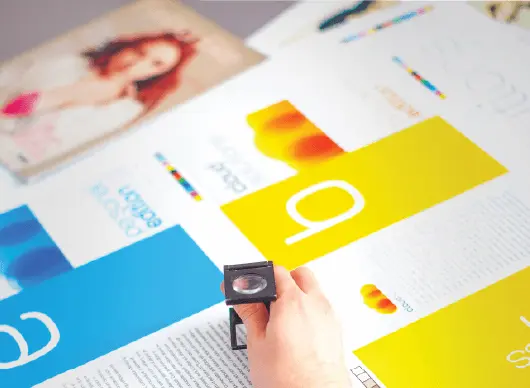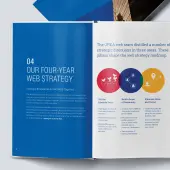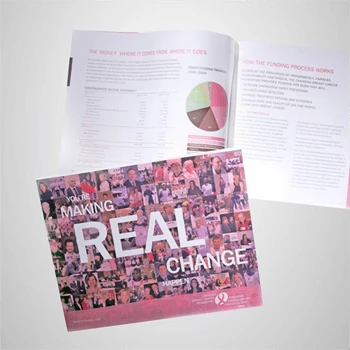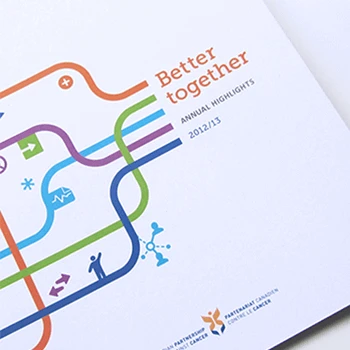What exactly is corporate communication design and why do we need it?
Corporate communication design ensures every communication vehicle results in consistent messaging and positive corporate recognition for both internal and external stakeholders. When your brand is applied to print-based collateral, that collateral becomes an extension of your identity, requiring strategic design that aligns with your overall Experience Thinking framework.
Tip: Audit all existing communication materials before starting new design work to identify consistency gaps and messaging conflicts that need addressing.
How does corporate communication design connect to the Experience Thinking framework?
Corporate communications bridge all four Experience Thinking quadrants - they express brand identity, deliver content strategy, support product experiences, and enhance service delivery. Effective communication design ensures stakeholders experience consistent brand expression across every touchpoint in your ecosystem.
Tip: Map your communication materials to each Experience Thinking quadrant to ensure all areas receive appropriate design attention and maintain consistency.
What makes corporate communication design different from general graphic design?
Corporate communication design requires deep understanding of organizational strategy, stakeholder needs, and brand positioning. It's not just about making materials look good - it's about creating communication vehicles that advance business objectives while maintaining brand consistency across diverse audiences and contexts.
Tip: Define clear communication objectives and success metrics before beginning design work to ensure materials deliver measurable business value.
Why is consistent messaging crucial for corporate communications?
Consistent messaging builds trust, reinforces brand positioning, and eliminates confusion among stakeholders. When communications contradict each other or vary wildly in tone and approach, audiences lose confidence in your organization's reliability and professionalism.
Tip: Create a messaging hierarchy that prioritizes key messages across different communication types and stakeholder groups to maintain focus and clarity.
How do corporate communications impact both internal and external stakeholders?
Internal communications shape employee engagement, understanding, and advocacy, while external communications influence customer perception, partner relationships, and market positioning. Both audiences need consistent but appropriately tailored messaging that reinforces your brand promise through relevant channels.
Tip: Develop stakeholder personas for your key internal and external audiences to guide tone, content depth, and channel selection for different communication pieces.
What role does corporate communication design play in brand experience?
Communication design is often the first and most frequent brand touchpoint stakeholders experience. These materials set expectations, communicate value, and reinforce brand personality through visual design, messaging approach, and information architecture decisions that influence perception and behavior.
Tip: Track which communication materials stakeholders encounter first in their journey with your organization to prioritize design investment and ensure strong first impressions.
How does effective communication design support business objectives?
Strategic communication design drives understanding, adoption, and action by presenting information in ways that resonate with target audiences. Well-designed communications reduce confusion, accelerate decision-making, and support sales cycles by clearly articulating value propositions and next steps.
Tip: Connect each communication piece to specific business objectives and establish measurement approaches to track effectiveness and return on design investment.
What's your approach to developing corporate communication design strategy?
We start by understanding your brand strategy, stakeholder needs, and business objectives, then develop communication frameworks that align with your Experience Thinking approach. This includes tone of voice guidelines, messaging hierarchies, and visual systems that work consistently across all materials and touchpoints.
Tip: Begin with a communication audit to understand what already exists before developing new strategy - this prevents duplicating effort and identifies reusable assets.
How do you determine the right tone of voice for corporate communications?
Tone of voice emerges from your brand persona and positioning strategy, reflecting how your organization would communicate if it were a person. We explore options through stakeholder workshops and audience testing to find the voice that authentically represents your brand while resonating with key stakeholder groups.
Tip: Test tone of voice with real stakeholders using sample communications rather than relying only on internal preferences - external perception often differs from internal assumptions.
What's your process for developing key messaging for corporate communications?
Key messaging development starts with brand positioning and value propositions, then adapts core messages for different stakeholder groups and communication contexts. We create messaging hierarchies that ensure priority information comes through clearly while supporting messages enhance understanding and engagement.
Tip: Develop a messaging matrix that shows how core messages adapt for different audiences and contexts while maintaining consistency in key value propositions.
How do you create communication systems that work across different media types?
We develop flexible design systems with adaptable components that maintain brand consistency while accommodating the unique requirements of print, digital, presentation, and environmental communications. This includes typography systems, color applications, and layout principles that scale effectively.
Tip: Plan for the most constraining medium first (often print) then adapt elements for more flexible media to ensure consistency across all applications.
What's your approach to information architecture for complex corporate communications?
We organize information based on stakeholder mental models and decision-making processes, creating hierarchies that guide readers through content logically. This involves card sorting, stakeholder interviews, and usability testing to ensure information flows support understanding and action.
Tip: Test information organization with actual stakeholders before finalizing design layouts to ensure logical flow matches audience expectations and needs.
How do you balance creative expression with corporate communication requirements?
Creative expression serves strategic communication objectives rather than existing for its own sake. We find innovative approaches that enhance message delivery and stakeholder engagement while respecting corporate standards, compliance requirements, and brand guidelines.
Tip: Establish clear creative boundaries and approval criteria upfront to enable bold thinking within acceptable parameters rather than constraining creativity unnecessarily.
What considerations guide communication design for different stakeholder groups?
Different stakeholders have varying information needs, communication preferences, and decision-making contexts. We adapt content depth, technical language, visual complexity, and calls-to-action while maintaining consistent brand expression and core messaging across all variations.
Tip: Create stakeholder journey maps showing how different groups interact with your communications to optimize design for their specific contexts and needs.
How do you ensure corporate communications align with existing brand standards?
We work within established brand systems while extending them appropriately for communication needs. This includes applying brand identity elements, following visual guidelines, and maintaining tone of voice consistency while adapting for specific communication contexts and stakeholder requirements.
Tip: Document any brand system extensions or adaptations created for communications so future materials maintain consistency and build on established patterns.
What's your process for creating comprehensive communication design systems?
We develop modular design systems with reusable components, templates, and guidelines that enable consistent execution across different materials and teams. Systems include typography hierarchies, layout grids, color applications, and content structure templates for various communication types.
Tip: Start with your most common communication types when building systems, then expand to cover specialized needs - this ensures immediate value while building toward completeness.
How do you handle communication design for both print and digital applications?
We design with multi-channel thinking from the beginning, creating flexible systems that adapt beautifully across print and digital while maintaining brand consistency. This includes responsive typography, scalable graphics, and content strategies that work effectively in different media contexts.
Tip: Consider how stakeholders might encounter the same information across multiple channels and design for cross-channel recognition and reinforcement of key messages.
What's your approach to template design for ongoing communication needs?
We create user-friendly templates that enable non-designers to produce professional communications while maintaining brand standards. Templates include clear instructions, locked design elements, and flexible content areas that accommodate various information types and lengths.
Tip: Test templates with actual users who will be creating communications to ensure they're intuitive and produce consistent results without requiring design expertise.
How do you ensure accessibility in corporate communication design?
We design with accessibility principles from the start, including appropriate color contrast, readable typography, clear information hierarchy, and alternative text considerations. This ensures communications reach all stakeholders effectively regardless of their accessibility needs.
Tip: Use accessibility requirements as design constraints rather than afterthoughts - they often lead to clearer, more effective communications for all audiences.
What's your process for quality control and brand compliance review?
We establish review processes that check both design execution and brand alignment before materials are finalized. This includes stakeholder approval workflows, brand compliance checklists, and quality assurance steps that ensure communications meet standards consistently.
Tip: Create approval templates that specify what reviewers should focus on at each stage to streamline the review process and ensure consistent feedback quality.
How do you handle version control and updates for communication materials?
We establish clear versioning systems and update processes that maintain current information while preserving design integrity. This includes master file management, approval workflows for changes, and distribution systems that ensure stakeholders access current versions.
Tip: Establish clear ownership and update responsibilities for different communication types to prevent outdated materials from circulating and confusing stakeholders.
How do you involve stakeholders in the communication design process?
We use workshops, interviews, and collaborative design sessions to gather stakeholder input and ensure buy-in throughout the process. This includes understanding their communication challenges, gathering content requirements, and involving them in concept development and refinement.
Tip: Include end users of communications (not just creators) in the design process to ensure materials work effectively for intended audiences.
What's your approach to gathering communication requirements from different departments?
We conduct stakeholder analysis to understand each department's communication needs, approval processes, and success metrics. This includes understanding how different groups use communications, what challenges they face, and how design can support their objectives.
Tip: Map stakeholder influence and communication frequency to prioritize whose input is most critical for successful design outcomes and adoption.
How do you handle conflicting stakeholder opinions about communication design?
We facilitate discussions that focus on stakeholder needs and business objectives rather than personal preferences. Using Experience Thinking principles, we guide conversations toward solutions that serve end-user needs while meeting organizational goals and maintaining brand consistency.
Tip: Establish decision-making criteria and authority upfront to resolve conflicts quickly and keep projects moving forward when stakeholder opinions diverge.
What training do you provide for teams creating ongoing communications?
We offer training on using communication templates, following brand guidelines, and applying design principles effectively. This includes workshops on content strategy, visual hierarchy, and approval processes that help teams create professional communications independently.
Tip: Focus training on the most common communication types and mistakes to maximize immediate impact and build confidence in using new design systems.
How do you ensure stakeholder buy-in for new communication design approaches?
We demonstrate value through examples, prototypes, and pilot projects that show how improved design serves stakeholder needs better than current approaches. This includes showing before/after comparisons and connecting design improvements to business outcomes stakeholders care about.
Tip: Start with stakeholders who are most open to change and use their success stories to build support among more skeptical groups.
What's your approach to managing approval workflows for corporate communications?
We design approval processes that ensure quality and compliance while minimizing delays and confusion. This includes clear role definitions, stage-gate reviews, and feedback consolidation approaches that streamline stakeholder input and decision-making.
Tip: Limit the number of reviewers at each stage and specify what type of feedback each reviewer should provide to prevent conflicting input and lengthy revision cycles.
How do you handle communication design for organizations with complex hierarchies?
We navigate organizational complexity by understanding decision-making structures, influence patterns, and approval requirements. This includes identifying key champions, understanding political dynamics, and designing processes that work within existing organizational frameworks.
Tip: Identify informal influencers alongside formal decision-makers - they often have significant impact on adoption and success of new communication approaches.
How do you measure the effectiveness of corporate communication design?
We establish metrics that connect communication design to business outcomes, including stakeholder comprehension, engagement rates, action completion, and feedback quality. This includes both quantitative measures and qualitative feedback that reveals how design impacts stakeholder experience and behavior.
Tip: Establish baseline measurements before implementing new communication design to demonstrate improvement and justify continued investment in design quality.
What's your approach to testing communication design with target audiences?
We use usability testing, comprehension studies, and feedback sessions to understand how stakeholders interact with communications. This includes testing information hierarchy, message clarity, visual effectiveness, and action completion to optimize design for real-world use.
Tip: Test communications in realistic contexts rather than isolated settings to understand how design performs when stakeholders are distracted or pressed for time.
How do you optimize communication design based on performance data?
We analyze usage patterns, feedback trends, and outcome metrics to identify improvement opportunities. This includes A/B testing different approaches, tracking stakeholder behavior, and making iterative refinements that enhance communication effectiveness over time.
Tip: Focus optimization efforts on the communication elements that have the biggest impact on your most important business outcomes rather than trying to perfect everything at once.
What frameworks do you use for ongoing communication design improvement?
We establish continuous improvement processes that regularly review communication performance, gather stakeholder feedback, and update design approaches based on changing needs. This includes scheduled reviews, feedback collection systems, and update protocols.
Tip: Schedule regular design reviews rather than waiting for problems to emerge - proactive improvement is more effective than reactive fixes.
How do you track return on investment for communication design improvements?
We connect design improvements to measurable business outcomes like increased stakeholder engagement, faster decision-making, reduced support requests, and improved satisfaction scores. This includes tracking efficiency gains and cost savings from better communication effectiveness.
Tip: Document time savings and efficiency improvements alongside aesthetic improvements to build a complete business case for design investment.
What's your approach to benchmarking communication design performance?
We establish performance baselines and compare results against industry standards, best practices, and your own historical performance. This includes tracking comprehension rates, engagement metrics, and stakeholder satisfaction to understand competitive position and improvement opportunities.
Tip: Focus benchmarking on metrics that matter most to your stakeholders rather than trying to measure everything - targeted measurement provides more actionable insights.
How do you ensure communication design improvements are sustainable long-term?
We build improvement processes into organizational workflows, create sustainable update procedures, and establish governance frameworks that maintain design quality over time. This includes training programs, quality checkpoints, and refresh schedules that prevent design decay.
Tip: Build design maintenance into regular business processes rather than treating it as a separate activity - integration ensures sustainability.
How do you handle communication design for complex technical information?
We use information design principles to make complex content accessible and actionable for different audience types. This includes visual hierarchy, progressive disclosure, analogies, and formatting approaches that help stakeholders understand and use technical information effectively.
Tip: Test technical communications with both expert and non-expert audiences to ensure information is accessible to decision-makers who may not have deep technical knowledge.
What's your approach to crisis communication design?
Crisis communications require clear, urgent, and trustworthy design that conveys critical information quickly while maintaining brand integrity. We design templates and systems that can be activated rapidly while ensuring information hierarchy guides stakeholders to the most important actions and updates.
Tip: Prepare crisis communication templates in advance with clear information hierarchies and approval processes to enable rapid deployment when time is critical.
How do you design communications for global organizations with diverse audiences?
Global communication design considers cultural differences, language requirements, and regional preferences while maintaining brand consistency. This includes flexible layouts for different text lengths, culturally appropriate imagery, and adaptation guidelines for local markets.
Tip: Design core communication systems with built-in flexibility for cultural adaptation rather than creating completely separate designs for each market.
What's your approach to internal communication design for employee engagement?
Internal communications require design approaches that break through information overload and engage busy employees effectively. We create systems that prioritize urgent information, make complex policies understandable, and encourage participation in organizational initiatives.
Tip: Design internal communications with employee workflow and attention patterns in mind - consider when and how employees will encounter information in their daily routines.
How do you handle communication design for regulatory and compliance materials?
Compliance communications must balance legal requirements with stakeholder comprehension and engagement. We design approaches that present required information clearly while maintaining reader attention and understanding of important obligations and procedures.
Tip: Work closely with legal and compliance teams to understand which elements are required versus recommended to focus design attention on the most important information.
What's your approach to designing investor and financial communications?
Financial communications require precise information presentation that builds confidence while clearly communicating performance and strategy. We design systems that present complex data accessibly while maintaining the professionalism and accuracy that financial stakeholders expect.
Tip: Use consistent data visualization approaches across all financial communications to help stakeholders quickly understand trends and comparisons.
How does AI impact corporate communication design and content creation?
AI tools can accelerate content creation, improve personalization, and enhance design efficiency through automated layout generation and content optimization. However, strategic thinking about stakeholder needs, brand positioning, and communication objectives still requires human expertise to ensure authentic and effective organizational communication.
Tip: Use AI to handle routine design tasks and content generation, but maintain human oversight for strategic decisions about messaging, brand expression, and stakeholder relationship building.
How involved will our team need to be during communication design projects?
Your team's involvement is crucial for content development, stakeholder insight, and approval processes. We'll schedule regular touchpoints for input, review, and refinement while managing the overall design process to minimize disruption to your daily operations and maximize collaborative value.
Tip: Identify team members who understand both your business objectives and stakeholder needs to maximize the value of collaborative design sessions.
What's your approach to project communication and updates during design work?
We provide regular progress updates, design rationale explanations, and milestone reviews that keep stakeholders informed and engaged. You'll have direct access to our design team for questions and will receive comprehensive documentation of design decisions and their strategic reasoning.
Tip: Establish clear communication preferences and review schedules upfront to ensure project updates enhance rather than interrupt your team's workflow.
How do you handle content creation versus design for communication materials?
We can work with existing content, help develop new content, or focus purely on design depending on your needs and capabilities. Our approach integrates content strategy with design development to ensure messaging and visual presentation work together effectively for stakeholder engagement.
Tip: Determine content ownership and creation responsibilities early in the project to avoid delays and ensure design and content development proceed efficiently.
What if our team disagrees with communication design recommendations?
We encourage open discussion about design decisions and provide clear rationale based on stakeholder research, best practices, and business objectives. Our goal is collaborative problem-solving that addresses concerns while maintaining design effectiveness and brand consistency.
Tip: Focus disagreements on stakeholder impact and business outcomes rather than personal preferences to reach solutions that serve organizational objectives effectively.
How do you work with our existing marketing and communications teams?
We integrate with existing teams rather than replacing them, bringing specialized design expertise to complement internal capabilities. Our approach enhances your team's communication effectiveness through better design systems, templates, and strategic frameworks.
Tip: Position external design expertise as enhancing internal capabilities rather than replacing them to build support and ensure smooth collaboration throughout the project.
What support do you provide after communication design projects are complete?
We offer ongoing consultation, template updates, and training support to help your team maintain design quality and adapt materials for new needs. Support levels vary based on your internal capabilities and the complexity of ongoing communication requirements.
Tip: Plan post-project support based on your team's design experience and the complexity of communication systems rather than assuming you can handle everything internally.
How do you ensure we get maximum value from our communication design investment?
Through strategic planning, stakeholder research, systematic design development, and measurement frameworks, we ensure communication design creates measurable improvements in stakeholder engagement and business outcomes. Our Experience Thinking approach connects design work to broader organizational objectives for amplified impact.
Tip: Define success metrics that connect communication design improvements to your most important business objectives so you can measure and communicate the value of design investment.












